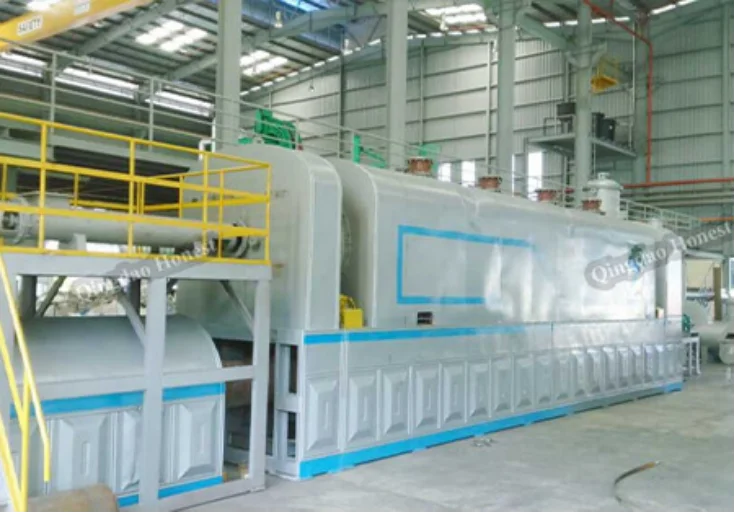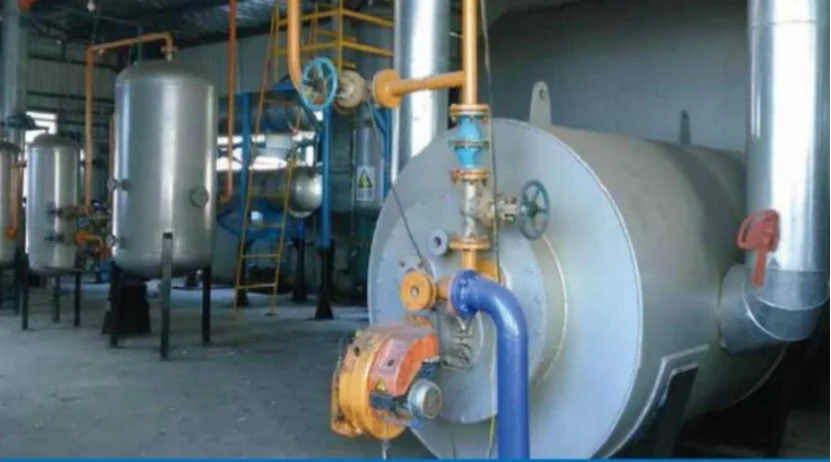
The pyrolysis process is a special way to break down stuff like plants or plastics. It happens without air, using high heat from 300°C to 900°C. This stops burning and turns materials into useful things like fuel oil, carbon black, and syngas. Many see it as a great way to turn trash into treasure.
The main idea of pyrolysis is breaking big molecules into smaller ones without air. This works well for hard-to-break-down waste like plastics and tires. The pyrolysis process has three steps. First, drying removes water. Next, heat breaks materials apart. Finally, cooling turns gases into liquids or solids.
The pyrolysis process helps manage waste in a green way. It’s better than dumping trash in landfills or burning it. It turns waste into useful products. This cuts down on trash piles and keeps the environment cleaner.
Plus, it makes valuable things like fuel oil and carbon black. These create money-making chances while helping the planet. Also, pyrolysis makes fewer harmful gases than other methods. This supports a healthier world.
Many industries use the pyrolysis process because it’s so flexible. In energy, the oil from pyrolysis can replace diesel in big furnaces or generators. In building, carbon black makes asphalt and concrete stronger.
Also, recycling industries use pyrolysis to turn old tires and plastics into new materials. For example, Qingdao Xingfu Energy Co., Ltd.’s fully automatic plastic pyrolysis plant gets 60-85% fuel oil and 10-30% carbon black from waste.
Plastics are tough to handle because they don’t break down easily. The pyrolysis of plastic to fuel is a smart fix. It turns plastic waste into fuel oil, syngas, and other useful stuff.
Fully automatic plastic pyrolysis plants can process mixed plastics from city trash or factories. These systems work well. They recover up to 85% fuel oil from plastics. They also use special dust-cleaning tech to protect the environment.
Old tire disposal is a big problem because tires don’t rot. The pyrolysis process helps by breaking tires into fuel oil, carbon black, steel wire, and syngas.
Qingdao Xingfu Energy Co., Ltd.’s whole tire pyrolysis plant doesn’t need tires cut up first. This saves money and time. It gets 40-45% fuel oil and 32-36% carbon black. Its sealed, hot feed system keeps heat in during work.
Making fuel with the pyrolysis process is good for nature. It keeps waste out of landfills and burners. This stops dirt in soil and bad air. Also, using these fuels cuts down on fossil fuel use. That lowers harmful gases.
Pyrolysis systems have high-tech filters, like pulse dust removal. These keep emissions clean and meet green rules. This makes pyrolysis a planet-friendly choice.
Carbon black is a fine powder made during the pyrolysis process. When materials get super hot, they break apart. This releases gases that turn into liquid fuels. The solid stuff left behind is carbon black.
Qingdao Xingfu Energy Co., Ltd.’s carbon black granulation system makes this powder into even bits, 10-100 μm big. It uses steps like wetting, mixing, shaping, and drying. This sealed system stops dust leaks and keeps making product without harming the environment.
Carbon black is super useful in many industries. It makes tires tougher and better. It’s also used in inks, coatings, plastics, and batteries because it’s strong and steady.
People want recycled carbon black from pyrolysis more now. It’s cheaper than new carbon black. This makes it a great pick for companies wanting green options.
Making recycled carbon black better is key to using it more. New shaping methods control particle size and make texture even. This boosts how well it works and makes it more competitive.
Using smart tech, like PRC-controlled material ratios and electronic packing systems, ensures steady quality. It also cuts down on handwork.
Old tire disposal is a big headache. Regular ways like landfills or burning don’t work well. Tires don’t break down, so they sit in landfills forever. They take up space and can leak bad chemicals into soil and water. Burning tires makes toxic gases and pollutes the air.
Also, these old methods waste valuable materials in tires. With millions of tires thrown out yearly, we need better solutions to handle this waste without hurting nature.
Pyrolysis technology changes how we recycle tires. It heats tires in a no-oxygen space. This breaks them into fuel oil, carbon black, steel wire, and syngas.
Qingdao Xingfu Energy Co., Ltd.’s whole tire pyrolysis plant is very efficient. It skips cutting tires, saving time and money. It gets 40-45% fuel oil, 32-36% carbon black, 14-16% steel wire, and 5-8% syngas. Its sealed, hot feed system keeps heat in.
Their broken tire pyrolysis plant is even better. It uses a multi-level cooling design to get more fuel oil. Its sealed, hot deslagging keeps things clean and green.
Tire pyrolysis brings big money benefits. It turns waste into products like fuel oil and carbon black that can be sold. This creates new cash flow and cuts the need for new materials. The fuel oil works in furnaces and generators. Recycled carbon black is a cheap swap for new carbon black in factories.
For the environment, tire pyrolysis stops landfill pile-ups. It cuts harmful gases from burning. High-tech filters, like pulse dust removal, keep emissions clean. This makes pyrolysis a green way to handle old tire disposal.
New tech makes the pyrolysis process better and bigger. Modern systems improve heat use and material breakdown. This gives more useful products.
Qingdao Xingfu Energy Co., Ltd.’s fully automatic waste tire pyrolysis plant uses strong welding and x-ray checks for safety. These upgrades make work smoother and keep products steady.
Also, new cooling designs boost fuel oil output and use less energy. This makes pyrolysis great for big waste projects.
Automation is changing the pyrolysis industry. Fully automatic systems make work easier by cutting handwork and mistakes. Features like PRC-controlled material ratios give exact control.
Qingdao Xingfu Energy Co., Ltd.’s semi-automatic plastic pyrolysis plant shows how automation helps. It handles feeding, cooling, and cleaning automatically. This boosts output with less harm to nature.
Real-time tracking systems also help. They watch things like heat and pressure. This lets workers make quick, smart choices for top performance.

Using the pyrolysis process worldwide can solve waste problems. Places with poor recycling can use small, easy-to-set-up pyrolysis units.
Governments are seeing pyrolysis as a green tool. Offers like tax cuts or funding could speed up its use.
Qingdao Xingfu Energy Co., Ltd., based in Qingdao city, makes custom solutions for different needs. Their skills ensure clients get systems that fit perfectly.
Tire pyrolysis cuts landfill use and makes useful products like fuel oil and carbon black. Clean filters keep air pollutants low during work.
Yes! Small or semi-automatic plants work well for small businesses. They keep efficiency and quality high.
Automation cuts handwork by handling feeding and tracking in real-time. This keeps performance steady.
Recycled carbon black is in high demand. It’s cheaper than new options, great for cars to construction.
Qingdao Xingfu Energy Co., Ltd., started in Shandong, offers custom designs for clients worldwide.